Abstract
The socio-demographic and epidemiological correlates of the total number of causes of death (TC) reported on death certificates were examined with multiple classification analysis (MCA). The data were all death certificates on white and black adult residents of Michigan who died at ages 25 or older in 1989 to 1991 (n = 222,763). TC was the sum of every morbid condition named as an underlying, intermediate, or immediate cause of death, or other medical condition contributing to death but not to its underlying cause. Autopsies performed for non-forensic reasons by physicians who are not Medical Examiners (MEs) likely yield the most accurate diagnoses of the underlying medical cause and counts of all other attendant causes, but they are extremely selective of decedents who are most closely integrated into the health care system. Thus we required a socio-demographic pattern in TCs to appear in a multivariate analysis not only for this special group of autopsied decedents but also for the non-autopsied masses before accepting the pattern as ‘real’' (not an artifact of underreporting of TC or confoundment with another socio-demographic variable).
The MCAs showed that age at death and its underlying medical cause were the most important factors related to TC, as suggested by epidemiologic transition theory. Compared with other underlying causes, diabetes, hypertension, and septicemia yielded the highest average TCs. While sex differences were generally not significant within racial groups, somewhat higher average TCs were found for blacks than whites and for lesser educated than for more educated decedents. These patterns in TC by race and education may reflect lifetime disadvantages faced by blacks and the less educated to health care or information about health practices.
Similar content being viewed by others
References
Battle, R.M., Pathak, D., Humble, C.G., Key, C.R., Vanatta, P. R., Hill, R.B. & Anderson, R.E. (1987). Factors influencing discrepancies between premortem and postmortem diagnoses, Journal of the American Medical Association258: 339–344.
CDC, Centers for Disease Control (1993). Monthly Vital Statistics Report41 (January).
Christenson, B.A. & Johnson, N.E. (1995). Educational inequality in adult mortality: An assessment with death certificate data from Michigan. Demography32(2): 215–229.
Guralnick, L. (1966). Some problems in the use of multiple causes of death, Journal of Chronic Diseases19: 979–990.
House, J.S., Kessler, R.C., Herzog, A.R., Mero, R.P., Kinney, A.M. & Breslow, M.J. (1990).Age, socioeconomic status, and health, The Milbank Quarterly68: 383–411.
Israel, R.A., Rosenberg, H.M. & Curtin, L.R. (1986). Analytical potential for multiple cause-of-death data, American Journal of Epidemiology124: 161–179.
Manton, K. (1980). Sex and race specific mortality differentials in multiple cause of death data, The Gerontologist20: 480–492.
Nam, C.B. (1990). Mortality differentials from a multiple cause of death perspective, in J. Vallin, S. D'souza & A. Palloni (eds.), Measurement and analysis of mortality: New approaches(pp. 328–342). Oxford: Clarendon Press.
Nam, C.B., Hummer, R.A. & Rogers, R.G. (1994). Underlying and multiple causes of death related to smoking, Population Research and Policy Review13: 305–325.
NCHS, National Center for Health Statistics (1993). Health United States 1992 and Healthy People 2000 Review. Hyattsville, MD: Public Health Service.
NCHS, NationalCenter for Health Statistics (1994).Vital statistics of the United States, Volume II, Mortality, Part A. Washington, DC: US Government Printing Office.
Omran, A.R. (1971). The epidemiologic transition: A theory of the epidemiology of population change, Milbank Memorial Fund Quarterly49(4): 509–538.
Parks, A.G. (1992). Testimony of ‘The challenging health care issues affecting older African Americans’, presented to the US House of Representatives Select Committee on Aging and the Congressional Black Caucus, 102nd Congress, First Session, 13 September 1991.Washington, DC: US Government Printing Office. Aging Comm. Pub. No. 102–846.
Rogers, R.G. (1995). Sociodemographic characteristics of long-lived and healthy individuals, Population and Development Review21: 33–58.
WHO,WorldHealth Organization (1977). Manual of the International StatisticalClassification of Diseases, Injuries, and Causes of Death, based on the recommendations of the Ninth Revision Conference, 1975. Geneva: WHO.
Author information
Authors and Affiliations
Rights and permissions
About this article
Cite this article
Johnson, N.E., Christenson, B.a. Socio-demographic correlates of multiple causes of death: Real or artifactual?. Population Research and Policy Review 17, 261–274 (1998). https://doi.org/10.1023/A:1005985730638
Issue Date:
DOI: https://doi.org/10.1023/A:1005985730638




